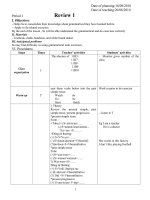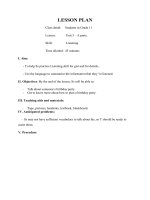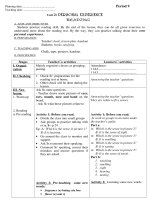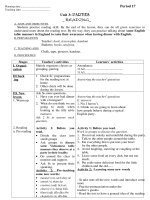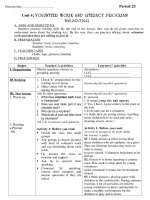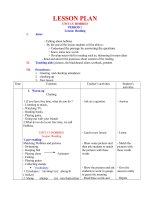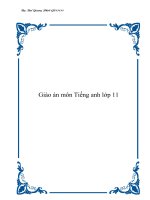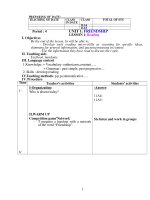Giáo án Tiếng Anh 11
Bạn đang xem bản rút gọn của tài liệu. Xem và tải ngay bản đầy đủ của tài liệu tại đây (744.94 KB, 183 trang )
UNIT ONE
FRIENDSHIP
Part A: Reading
I. AIMS OF THE LESSON :
1. Language skills :
• Reading :
- How to read the poem, especially the intonation.
- Read and try to guess the meanings of words and expressions
- Passage comprehension.
- Finding the main content of the lesson.
2. Language focus :
Vocabulary : mutual, incapable of, unselfish, acquaintance, give-and take
loyal to, suspicious
• Grammar :
- The simple present.
- Mutual pronoun “each other”.
II. TEACHING AIDS : cassette player, tape, chalks, pictures, handouts, charts , real objects if
possible
III. PROCEDURE :
STAGES TEACHER’S ACTIVITIES STUDENTS’ ACTIVITIES NOTES
Pre-
Reading
(5’)
- Play the cassette
- Ask students to pay attention to
the intonation
- Teacher goes around for helps.
-Listen once or twice
-Discuss the answers to the
questions.
-Model the discussion in front of
the class.
Pairwork
While-
Reading
(28’)
- Introduce three tasks.
-Have students read the whole
passage (once or twice) and do the
tasks.
* TASK 1:
-Guide students how to do this task.
- Teacher goes around for any help.
-Compare the results of the others
and correct mistakes.
-Read silently.
- Choose the correct word in the
box to complete each sentence.
- Keys: 1.mutual 2. incapable of
3. unselfish 4. acquaintance, friend
individual/
pairs
1
* TASK 2:
-Ask students to read the four
sentences in the textbook and
choose the best answer
- Compare the result and correct
mistakes.
* TASK 3:
-Have students discuss questions.
-Observe class and help students.
- Teacher goes around for any
helps.
- Correct mistakes.
5. give-and-take 6. loyal to
7. suspicious
-Key: B
-Suggested keys:
1. The first quality for true
friendship is unselfishness. It tells
me / us that a person who is
concerned only with his own
interests and feelings cannot be a
true friend.
2. Changeable and uncertain people
are incapable of true friendship
because they take up an interest
with enthusiasm, they are soon
tired of it, and they feel the
attraction of some new object.
3. The third quality for true
friendship is loyalty. It tells us that
two friends must be loyal to each
other, and they must know each
other so well that there can be no
suspicions between them.
4. There must be mutual trust
between friends because if not,
people cannot feel safe when
telling the other their most intimate
secrets.
5. Talkative people can’t keep a
friend long because they can’t keep
a secret, either of their own or
others.
6. The last quality for true
friendship is sympathy. It tells us
that to be a true friend, you must
sympathize with your friend.
Where there’s no mutual sympathy
between friends, there’s no true
friendship
Pair-work
Pair-work
Post - Teacher asks a general question, Students give their opinions Group-
2
reading
(10’)
“Why do we need true friendship?” Discussion work
IV. HOMEWORK : (2’)
UNIT ONE
FRIENDSHIP
Part B: Speaking
I/ Objectives:
- Describing physical characteristics
- Discussing personalities
- Role-play : Talking about a famous friend
II/ Teaching aids:
- Gestures
- Pictures
3
III/ Procedures:
STAGES TEACHER’S ACTIVITIES STUDENTS’ACTIVITIES
Warm-up
(2’)
- Ask some questions:
1/Do you concern about your outlook ?
2/ Is it important to you ?
- Lead sts to the main content
- Answer :
* Yes , I do..
* Yes , it is..
Pre-speaking
(4’)
- Present some new words
* characteristic (n)
* personality (n)
* forehead (n)
* crooked (a)
* hospitable (a)
- Listen carefully
- Take notes
While–reading
(29’)
Task 1
- Ask sts to look at the pictures (page 15)
and answer questions :
1. How many people are there in the
picture ?
2. Can you guess how old they are ?
- Explain the useful language (page 16):
* height : tall , medium , short …
* face : square , large , oval …
* forehead : broad , high …
* nose : straight , crooked …
* hair : black , grey …
* appearance : handsome , beautiful ,
good-looking …
- “ Now let‘s start with the physical
description of each person , using the
guided
+ question : Can you describe the _____
in the picture ? “
+ answer : The ____ is height . He / she
has ____ face , and a _____ nose . His /
her hair is _____. His / her appearance is
______ .
- Look and answer questions :
1. There are 4 .
2. - The boy is 20 .
- The girl is 16 .
- The man is 42 .
- The woman is 28
- Listen and take notes .
- Help sts with some new words.
- Ask sts to make questions and answer
questions with a partner, using the
information from the picture .
+ The boy is short . He has a
large face , …
+ The girl is ………
- Play roles.
4
- Ask sts to perform.
- Correct sts’mistakes and
pronunciation .
Task 2
- Divide class into four groups .
- Explain some words of personalities on
page 16 .
- Guide them to discuss and decide
which personalities are important to a
person and in friendship .
- Let sts number the following
personalities in order of importance in
friendship .
caring , hospitable , modest , sincere ,
generous , honest , helpful ,
understanding , pleasant
-Pay attention that there’re no answer
keys for this task
-Present their performance.
- Work in groups of four .
- List some personalities of a
person.
- State some reasons why they
choose .
- Discuss and say the reasons .
- Report their results to the class
and explain why they do like
that ..
Post-speaking
(10’)
Task 3
- Have sts work in pairs .
- Guide them to do the task .
- Make sure that sts understand their
roles
- Pay attention to the suggestions :
+ his / her name
+ date of birth
+ his / her physical characteristics
+ his / her hobbies
+ his / her personalities ( friendly ,
humorous , quick-witted , good-natured ,
helpful , honest , pleasant , caring )
+ why he / she interests in Maths
+ how much time he / she spends on
Maths everyday
+ what makes him / her a good friend
+ what made him / her successful
( studious , intelligent , keenly interested
in Maths , eager to learn , patient , calm )
+ what he / she does in his / her free time
- Call some pairs to report .
- Make pairs : one is a journalist
, the other is an interviewee .
- Listen carefully .
- Practise in pairs .
- Pay attention to the content :
+ physical characteristics
+ personalities
+ reasons why the friends are
famous
- Role play
- Perform their task .
IV. Homework
- Learn by heart some new words .
- Prepare part C : Listening
5
UNIT ONE
FRIENDSHIP
Part C: Listening
I. Objectives: - To practise listening comprehension skill.
- To distinguish true and false statements.
- To take notes about given questions in order to answer.
II.Language materials: Key words.
III.Teaching aids: Textbook, chalk, cassette, cassette player.
IV. Teaching steps:
1- Greetings and attendance checking. 3’
2- Oral test (previous lesson) . 5’
3- The new lesson. 31’
4- Consolidation (summary). 3’
5- Homework. 3’
Stages
Warm up 3’
Pre-listening8’
Teacher’s activities
-Ask students some questions about
friendship:
• Who is your best friend?
• What qualities & characteristics
of your best friend do you
admire?
-Ask students some more questions:
• How do you meet your best
friend?
Students’ activities
-Volunteer students answer
-The pointed students
answer
6
While-listening
15’
Post-listening5'
Homework 3’
• How long have you known your
best friend (him or her)?
-Explain some new words & phrases:
Residential area, ring (n), ride/ rode/
ridden, motorbike, happen to infinitive
(v), introduce, ever since, college, great
sense of humour, favourite, interest (n),
plays (n), movies, a rough time.
-Have students read the true-false
statement list and questions in textbook
silently for several minutes to make sure
that every student understands them
(Task1, 2)
-Check again if students are able to
understand main requirements of the 2
tasks
-Emphasize “ you will hear Lan & Long
talk about their best friends_Ha & Minh.
Listen to their talks and do the tasks
below”.
-Turn on the cassette player twice.
-Ask some students to do their tasks on
the board.
-Correct and give score
-Have students ask & answer about the
friendship between Lan and Ha, Long
and Minh (How & Where they met, what
they like about their friends.
-Ask students to rewrite their answers
completely
-Students repeat & take
notes
-Students read task1, 2
silently for gist
-Elicited students raise their
hands to interpret.
-Students take notes during
listening.
-Other students watch and
give comments.
-Students work in pairs.
-Students rewrite their
answers of tasks 2 in their
notebooks at home
Key content
Where & how they met What they like about their friends
Lan -They used to live in the same
residetial area in Ha Noi.
-Lan went on a holiday to Do Son &
Ha went there to visit her.
-Ha is very friendly & helpful.
-Ha is sociable. She’s got many friends in
Do Son & she introduced Lan around.
Long -They met in the college.
-Minh played the guitar, Long was a
singer.
-They worked together.
-Minh has a sense of humour.
-Minh likes to go to plays & movies.
-Minh is a good listener.
-Minh is friendly & helpful
Lan’s talk : 1f, 2f, 3t, 4f, 5t, 6f Long’s talk : 1f, 2f, 3t, 4t, 5t,
7
UNIT ONE
FRIENDSHIP
Part D: Writing
* OBJECTIVES
-Aims: Help students learn how to write a passage to describe a friend they like.
-Lexical items : Words / phrases used to describe someone’s physical characteristics and
someone’s personalities.
-Teaching aids: A copy of a passage of describing people.
* PROCEDURE
STAGES TEACHER’S ACTIVITIES STUDENTS ’ACTIVITIES
PRE- WRITING
(7’)
WHILE- WRITING
(25’)
Warm -up
- Teacher asks students to think about a
friend they like.
-Teacher raises a few guiding questions.
1. What is your friend name?
2. How old is he / she?
3. Where and when did you meet each
other?
-Teacher uses a picture to gives some key
words to describe someone’s physical
characteristics ( height , hair , eyes , face ,
clothes…) and his / her personalities
( helpful , sincere…) and some necessary
structures.
-Teacher gives a sample and has students
write a passage to describe a friend they
like.
A Sample
Students ‘answers
1. My friend’s name is Hoa
2. She is 17 years old.
3. We met each other at my
cousin’s birthday party 4 years
ago .
-Students write a passage.
8
POST- WRITING
(13’)
Hoa has been my best friend since many
years.She is quite a lively person. She is
fairly tall with a good fingure.She ‘s got a
heart- shaped face with a small sort of
turned- up nose. It is very attractive . She
has got long , black wavy hair and blue
eyes with very long eyelashes.Her
complexion is white. Her lips are very full
and she has got dimples in her checks.
Now she lives very far from me , but we
still keep contact through e- mail .
-Teacher asks students to read / write
some students’passsages on the board and
Teacher gives comments.
-Students read / write some
students’passsages on the
board.
* HOMEWORK:
-Prepare E. LANGUAGE FOCUS
9
UNIT ONE
FRIENDSHIP
Part D: Language Focus
* Objective :
- Ss can distinguish and pronounce two sounds /ʤ/ & /ʧ/ in single words and sentence.
- Ss can review infinitive, bare infinitive and use them
* Teaching aids : textbook, pictures.
* Procedures :
Time Contents Teacher’s activities Ss’ activities
5’
10’
28’
I. WARMER:
Show the Pictures on the blackboard:
+ chair, children, chewing gum
+ Jacket, Jean, July
Introduction
II. PRONUNCIATION:
/ʧ/ /ʤ/
Chain Jail
Choke Village
Cheek June
Beach July
Peach Surgeon
Rich Region
Match Jerry
1. Listen and decide if the word belonging to /ʤ/
or /ʧ/
Age, each, coach, college, chew, junk, jeans,
Joke, purchase, magic, tragic, butcher
2. Open their book (page 19). Listen and repeat
III.GRAMMAR AND VOCBULARY:
1.INFINITIVE :
-What do you study English for?
-What do you want to do after school?
-What do you do morning exercise for?
- Asks Ss to look at the
pictures.
- What do you call in
English?
- Ask Ss to repeat to
introduce 2 sounds /ʤ/
& /ʧ/
- Ask Ss to repeat
- Give Ss a handout to
collect
- Asks Ss to listen and
check
- Plays the cassette
- Helps Ss to correct
- Elicit
- Introduce Infinitive
- Look at
- Answer
- Repeat
- Repeat
- Collect
- Check
- Repeat
- Practise in pairs
- Answer
to find a good job…
to be a teacher..
10
-What do you use phone for?
• After verbs : want, have, decide, buy, would
like, seem…….use “to Infinitive”
• Meaning :“To Infinitive” is used to express a
purpose
* Exercises 1:(page 20)
Key:
1. Who wants st to eat?
2. I have some letters to write
3. I am delighted to hear the news
4. My mother has some shopping to do
5. You always have too much to talk about
6. It’s lovely to see you again
7. It’s too cold to go out
8. I am happy to know that you have pass the exam
• Practise :based on prompts:
S1:who/ want/ talk with?
S2:……….
S1:what/do/tonight?
S2:have/exercises/do
S1:what/decide/do/high school?
S2:………
S1:why/morning exercise?
S2: keep health
2. BARE INFINITIVE :
Giang: Where is Linh?
Tuan: I saw him go out 5 minutes ago
Giang: what is the matter with him?
Tuan: I heard him say to Nam he had a headache.
He went to see the doctor.
VERB: see, hear, feel, make, let, watch + V
0
* Exercise 2 : page 21
Key :
1.The police watched them get out of the car
2.They let him write a letter to his wife
3.I heard them talk in the next room
4.The customs officers made him open the
briefcase
5.The boy saw the cat jump through the window
- Asks Ss to do
- Correct
- Ask ss to practise in
pairs
- Call some pairs
- Give Ss a situation.
“There are 4 people
living in the house.
They are close friends.
They are Giang, Linh,
Tuan, Nam. However,
Giang doesn’t know
where Linh goes, and he
asks Tuan :
- Ask Ss to remark
Gives some verbs
followed bare infinitive
- Ask Ss to do exercises
on page 21
- Correct
to keep health..
to contact my friend
- Take notes
- Work in pairs
- Practise in front of
class
- Take notes
- Give their remark
(after verb:see,hear
use bare infinitive)
- Do exercises
- Take notes
11
2’
6.Do you think the company will make him pay
some extra money?
7.I felt the animal move toward me
8.Do you think her parents will let her go on a
picnic?
Practise :based on prompts
* S1:I /see/them/go out
S2:where/they/decide/go?
S1:…………
* S1:What/happen?
S2:I/ see/ rabbit/jump/the window
S1:Oh!really?
* S1:what about /trip / Dalat, Lan?
S2:I / be / afraid. I can’t
S1:What / the problem / you?
S2:My friends/make/me/stay there/8 days
S1:But/my parents/ not let/me/stay there 8 days
S2:what a pity!
IV.HOMEWORK :
-learn their lesson
-prepare the new lesson
- Ask Ss to practise in
pairs based on prompts
- Encourage Ss to make
situation to use the
above verbs (feel,
make, let…)
- Call some pairs to
present
- Ask Ss to pay attention
to using these Verbs
- Work in pairs
- Present in front of
class
- Take notes
- Take notes
12
UNIT 2
PERSONAL EXPERIENCES
Part A : Reading
I. Objectives :
- Help students understand the content of the lesson.
- Help students understand the new words and use them in context.
II. METHODS :
Communicative approach
III. TEACHING AIDS :
Pictures, chalks, cassettes
IV. TEACHING PROCEDURES
Content Teacher’s activities Students’ activities
- NEW WORDS
1. embarrass(v)
- embarrassed(adj)
- embarrassing(adj)
- embarrassment(n)
2. idol (n)
3. glance(n/v)
- glance at sb/sth
4. Be busy doing sth
Be busy with sth
EX: I’m sorry. I can’t go with
- Warm up:
A. Pre-Reading
- Ask students to put the pictures in the
book in the correct order to make a
story. (work in pairs)
- Ask some students to give their
answers.
( teacher doesn’t need to give feedback)
- key : d, b, f, e, a, c
- Let’s begin our lesson you’ll know the
whole story.
- Ask students to listen to the tape
B. while – reading
- Ask students to read the whole story
- Explain some difficult words and
structures
- The Beatles were the pop idols of the
60s.
- Put the pictures in the
book in the correct
order to make a story. (
work in pairs)
- Give their answers
- Listen to the tape
- Read the story
- Listen, try to guess
the meaning of the new
words and take notes
13
you now. I am busy with my
homework. I’m busy doing
my homework.
5. note (n) banknote
EX
Do you want the money in
the notes or coins?
Task 1:
1. glanced
2. makes a fuss
3. embarrassing
4. idols
5. sneaky
Task2:
1.d 2.b 3.c
4.f 5. e 6.a
Task3( suggested answers)
1. She wished to have a red
hat-a floppy cotton hat ( like
the one her star idol wore in
her video clip)
2…...so that she could buy
the hat ( for herself.)
3. She saw a wad of dollar
notes ( exactly like the one
that her father had given her).
4. Because she thought the
boy had stolen her money / it
was her money.
5. She bought the pretty hat
of her dream.
- Ask students to do Task 1 in pairs
Give feedback
-Ask students to do task 2 in groups
- Give feedback
-Ask students to read the questions in
task 3 and answer them in groups.
- Ask representative of each group to
give oral answers and write them on the
board.
- Give feedback
Post- reading
-Ask students to discuss the questions in
group:
1. How did the girl in the story feel
when she discovered that the money she
had taken was not hers?
(embarrassed, sad, ashamed, unhappy,
terrible, uncomfortable, anxious, …)
2. What did the girl have to do (when
she discovered that the money she had
taken was not hers )?
( put a notice on T.V or at school, get
on the same bus on the next day to look
- Do Task 1 in pairs
_Take notes
- Do task 2 in groups
- Take notes
- Read the questions
silently and answer
them in groups
- Give the answers
- Take notes
- Discuss in groups
14
for him, do nothing, keep it a secret, tell
her father everything and ask him for
advice,…)
- Ask some students to represent their
talk in front of class
- Report before class
V. HOMEWORK
- Write down the questions and the answers in the notebooks
- Learn by heart the new words and questions
- Prepare in advance Part B – Speaking
UNIT 2
PERSONAL EXPERIENCES
PART B : Speaking
I.OBJECTIVES:
- Students can talk about their personal experiences
- Students can do Task 1,2,3
II. METHODS :
15
- Communicative approach
III. TEACHING AIDS:
- Pictures, chalks, cassettes.
IV. TEACHING PROCEDURES
CONTENT TEACHER’S ACTIVITIES STUDENTS’ ACTIVITIES
NEW WORDS
1. Confidence
2. Attitude
3. Native English speaker
4. Appreciate
TASK 1
+ Structure:
Present Perfect ( Past simple)
Have you ever……………?
1. D 2. E 3. B
4.F 5. A 6. C
TASK 2
1. B 2. E 3. H 4. A
5. E 6. G 7. C 8. F
TASK3
1.
A. Have you ever feeled an exam?
- Yes, I have.
B. How did it happen?
- I didn’t study well enough for
exam.
C. When did it happen?
- Last year.
D. How did you feel/ How did it
affect you ?
- I felt disappointed/ sad/
depressed.
2.
A. Have you ever traveled to other
parts of the country?
- Yes, I have.
B. When did you travel?
- In 2002.
C. How did it affect you?
- It make me love our country
+Warm up
- Have you ever spoken English
to you friends ( teachers,
foreigners…) ?
- How did you feel when you
spoke English to them?
+ Pre-Speaking
- Give students some new
words in Task 1
- Read the new words
- Ask students to do Task 1 in
pairs
- Give feedback
+ While-speaking
- Ask students to do Task 2 in
pairs
- Ask them to give answers
TASK 3
- give students useful structures
+ Have you ever………….?
+ How did it happen ?
+ When/ Where did it happen?
+ How did the experience
affect you? / How did you feel?
- Ask students to do Task 3 in
pairs
- Ask some pairs to perform
their dialogues in front of the
class.
- Correct common mistakes and
give remarks
- Give answers
- Do Task 1 in pairs
- Work in pairs
- Give answers
- Give answers
- Do Task 3 in pairs
- Perform their dialogues in
front of the class.
16
more./ I learned more about
different places in our country.
3.
A. Have you ever talked to a
famous pop star?
- Yes, I have.
B. Where did you meet him/ her ?
- At a party
C. How did it affect you?
- It was interesting to talk to
famous pop stars.
- It changed my attitude to/
towards/ famous pop stars.
- Give good marks to good
groups/ students to encourage
them
V. HOMEWORK
- Write down the dialogue in Task 3
- Prepare Part C ( Listening ) in advance.
PART C: LISTENING
I.OBJECTIVES:
- Help students improve their listening skill.
- Help them understand the conversation and do Task 1,2
II. METHODS :
- Communicative approach
III. TEACHING AIDS:
- Pictures, chalks, cassettes.
IV. TEACHING PROCEDURES
CONTENT TEACHER’S ACTIVITIES STUDENTS’ ACTIVITIES
TASK 1
1.F 2. F 3. F 4.F
5.F
+Warm up
- Have you ever seen a fire ?
- Where did it happen?
- Was it frigtening?
+ Pre-listening
- Ask students to look at the picture in
the book and ask them some questions
+ What is happening?
( The house is burning./ The house is
on fire./…..)
+ What is she doing?
( She’s talking a little girl out of the
burning house )
- Ask students to repeat the provided
words and explain the words if
necessary
+ While-listening
- Ask students to read Task 1 silently
- Ask students to listen to the tape
( twice).
- Ask students to do Task 1
- Give their answers
- Give theirs answers
- Listen and repeat in chorus
- Read Task 1
- Listen to the tape and decide
17
TASK 2
1.grow 2.small
3. everything 4. realize
5. family 6. replaced
7. took 8. family
individually.
- Read the sentences again to help
weak students:
1. We talk to Christina, a successful
business woman
2. My most unforgettable experience
happened 13 years ago
3. The fire started in the kitchen where
I forgot to turn off the gas stove.
4. I was sleeping when I was suddenly
woke up by terrible heat.
5. I heard my mother’s voice calling
my name.
- Give feedback
- Ask students to read Task 2 silently
and listen to the tape again.
- Ask two students to write the answers
on the board
- Give feedback
whether the statements are true
or false
- Give answers and take notes
- Listen and do Task 2
- Give answers
- Take notes
UNIT 2
PERSONAL EXPERIENCES
Part D : Writing
I. OBJECTIVES:
- Students can write a personal litter to describe their past experience
II. METHODS
- Communicative approach
III. TEACHING AIDS:
- Chalks, textbooks
IV. TEACHING PROCEDURES
CONTENT TEACHER’S ACTIVITIES STUDENTS’ ACTIVITIES
Warm-up
- Can you write a short letter in
English?
- Is it interesting?
- To day I want you to write a
letter about your past
experience in English.
+Pre- Writing:
- Have students give some of
their past experiences?( being
seriously ill, failing an exam;
talking to a famous pop star,…
etc
- Give answers
-Take notes
18
NOTES
1. When it happened:
( It happened …years
ago/in …./ when I was
…years old.)
2. Where it happened:
( in my house/ at school /
in the street)
3. Who was involved:
( your family members/
your friends/ your
relatives,….)
4. How it affected you:
( it changed outlook
life / it make me more
careful/ it gave me more
confidence in …./ it
taught me the lesson/…)
+ While- writing
- Give students some guidance
- Ask students to write a
passage about the most
memorable past experience.
- correct common mistakes
- Work in groups
- Write the passage in the book.
V. HOMEWORK
- Prepare Part E ( Langue Focus) in advance
19
UNIT 2
PERSONAL EXPERIENCES
Part E: Language Focus
I. OBJECTIVES:
- Students can pronounce the sounds / m /, / n / / 0 /
- Present tense forms indicating past time
- Tense revision : Past Simple, Past progressive and Past Perfect.
II. METHODS
- Communicative approach
III. TEACHING AIDS:
- Chalks, pictures, textbooks, blackboard
IV. TEACHING PROCEDURES
CONTENT TEACHER’S ACTIVITIES STUDENTS’ ACTIVITIES
I. Pronunciation
+Warm- up
- Write some sentences on the
board and ask some students
to read them aloud
- Underline the sounds /m/
/n / / 0 /
Ex:
- We like singing mery songs
on New Year’s Day.
- They live in a nice small
house.
+Pre
- Ask students to look at their
books, listen and repeat the
words in the colums
+While
- Ask students to read the
sentences
+Post
- Practise reading the
sentences
- Read the sntence
- Listen and repeat the words
in colums, the sentence in the
book
20
GRAMMAR
TENSE REVISION
- The present tense use to tell a
story that happened in the past
makes it more interesting and
vivid
Exercise1 ( suggested key)
1. lives 2. invites 3. sets
4. gets 5. waves 6. promises
7 carries 8. contains 9.has baked
10. is 11. is shining
12. are singing 13. is
Exercise 2 ( suggested key)
1. broke / was playing
2. wrote / was
3. was working/ broke
4. stared / were walking
5. told / were having
6.
7.
8.
Exercise 3 ( suggested key)
1. had eaten / arrived
2. found / had taken
3. got / had closed
4. got / had left
5. got / had arrived
6.
7.
8.
GRAMMAR
+Warm- up
We’ve already learn the
present simple tense, the past
simle tense, the past
progressive tense. Now we
are going to review them
+Pre
-Ask students to remember
the use of these tenses
+While
- Ask students to do exercise
1 in pairs
- Correct the exercise and
explain the use of the tenses
-Ask students to do exercise 2
- Give feedback
- Ask students to do exercise
3 individually
- Explain the difference
between the simple past and
the past perfect.
- Correct the exerciseand
explain the use of the tenses
+Post
- Consolidate the use of tense
- Do exercise 1, then give
answers
- Work in pairs, give theirs
answers
- Work in pairs and give their
answers
- Listen
- Give answers
V. HOMEWORK
- Practise reading the sentences
- Write exercise 2,3 in the notebook
- Prepare in Unit 3 part A reading in advance
21
UNIT 3
A PARTY
Part A : Reading
I . Objectives
How to understand and use new words in context
II . Methods:
Communicative approach
III . Teaching aids:
Pictures, cassettes, OHP
IV . Teaching procedures
STAGES TEACHER’S ACTIVITIES STUDENTS’ ACTIVITIES
• Warm-up (3`)
A. Pre-
Reading(7`)
B. While –Reading
(25`)
- Ask students to look at the first
picture in the book and ask them some
questions:
• Are they having a party ?
• What party is it ?
-Ask students to look at the second
picture and ask some questions:
• Are they friends ?
• What are they celebrating ?
• How old are the people in the
picture ?
• How do they feel ?
• How long have they been
married ?
* The lesson today gives us some
information about birthday and
wedding anniversaries in the US.
- Ask students to listen to the tape
- Ask students to read the passage
silently
- Explain some difficult words
New words:
1. celebrate (v)
celebration (n)
2. joke (v/n)
Ex: Don’t believe me . I’m only
joking.
- Look at the first picture and
give answers
• Yes, they are
• It is a birthday party.
• No, they aren’t.
• A golden wedding
anniversary.
- Listen to the tape
- Read the passage silently
- Listen and take notes
22
C. Post –
Reading (10’)
3. anniversary (n)
+silver anniversary / silver
wedding / silver jubilee : 25
th
wedding anniversary.
+ golden anniversary / golden
wedding / golden jubilee: 50
th
wedding anniversary.
+diamond anniversary / diamond
wedding / diamond jubilee: 60
th
wedding aniversary.
TASK 1
-Ask students to do Task 1 in pairs
-Give feedback
Suggested answers
1&2 (Both) 3&6(Birthday) 4&5
(Anniversary)
TASK 2
-Ask students to do task 2 in pairs
- Give feedback
- Suggested answers
1. eighth(seventh)
2. brings(eats)
3. food(presents)
4. anniversaries(age)
5. months(year)
6. 5
th
(50
th
)
7. silver (golden)
- Ask students to talk about their
birthday party. ( work in groups)
(place, time, guest, foods, drinks,
activities)
-Do Task 1 in pairs.
-Take notes
-Do Task 2 in pairs
-Take notes
- Talk about their birthday
party in groups
IV. Homework: 1. Do the tasks again in notebooks.
2. Prepare : Part B – Speaking.
UNIT 3
23
A PARTY
Part B: Speaking
I. Objectives:
- Students can talk about a plan for their birthday party or his / her friend’s party.
- Students can do tasks 1,2,3.
II-Methods:
Communicative approach.
II. Teaching Aids : cassette player, chalks, pictures.
III. Teaching Procedures
24
STAGE TEACHER’S ACTIVITIES STUDENTS’ACTIVITIES
Warm-up
+
Pre-speaking
(10 minutes)
While-speaking
(25 minutes)
Warm-up:
Do you like parties ?
Do you like quiet or noisy parties ?
Show the picture in the textbook and
ask:
Are they having a party ?
What does ‘party-goer’ mean ?
Ask students to do Task 1 in pair.
TASK 1:
Are you the perfect party-goer ?
1. Which kind of parties do you prefer ?
-big / small / noisy / quiet parties
-parties with dancing and games
2. You find yourself standing with a
complete stranger at a party. What
would you do ?
-talk about yourself / the weather.
-try to get him or her talk about himself
or herself
3. at a party, what would you tend to
drink ?
-beer / soft drinks / mineral water
TASK 2:
-Ask students to do Task 2 in pairs
-Ask some pairs to perform their talk
before class.
A: I am wondering where I should hold
my birthday party ?
B: Why don’t you have your birthday
party at home ? It’s cosy and not very
expensive.
A: I don’t know if it’s suitable to begin
at 5 pm ?
B:
• Why don’t you….
• You ought to…
• You should…
• I think you should…
• You’d better….
• If I were you I would…
*Where (home-cosy, not expensive, not
spend a lot of time to prepare, not have
to clean up…
*What time
*How many guests
*What to eat / drink (soft drinks, mineral
water…./ ckicken soup, green salad,
steak, fired chicken, fish, beef,
hamburger, cake…)
*What to wear (dress, jeans, shirts, T-
shirt, pullover, skirt…)
*Which activities (singing, playing
games, taking photographs, give gifts…
-Give answers.
- Do Task 1 in pairs.
- Perform their talk in class.
- Do Task 3 in groups
25
